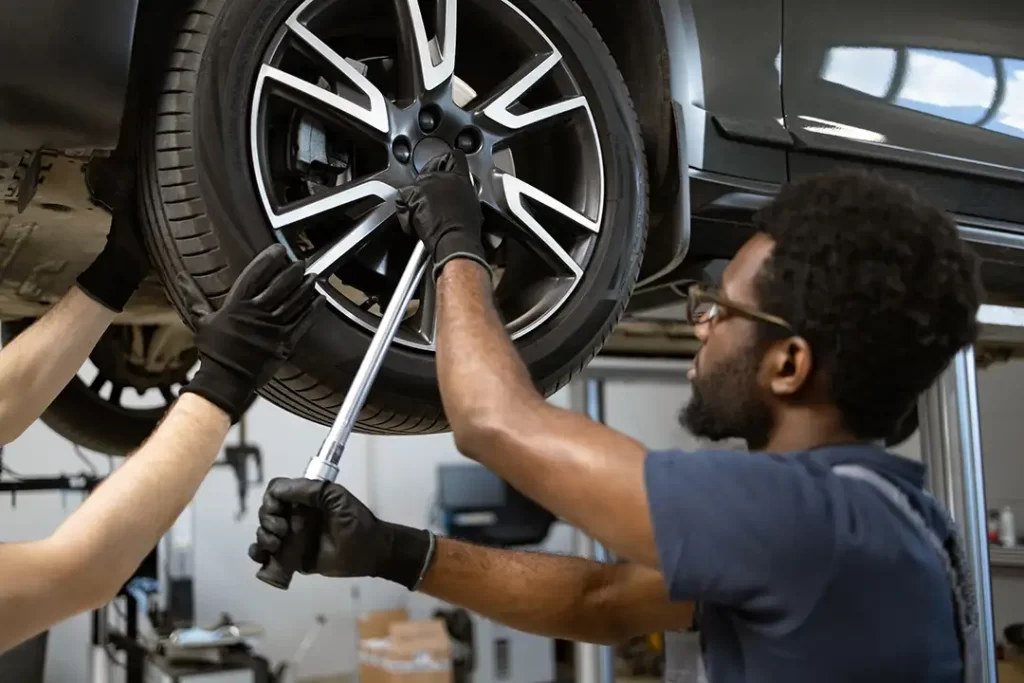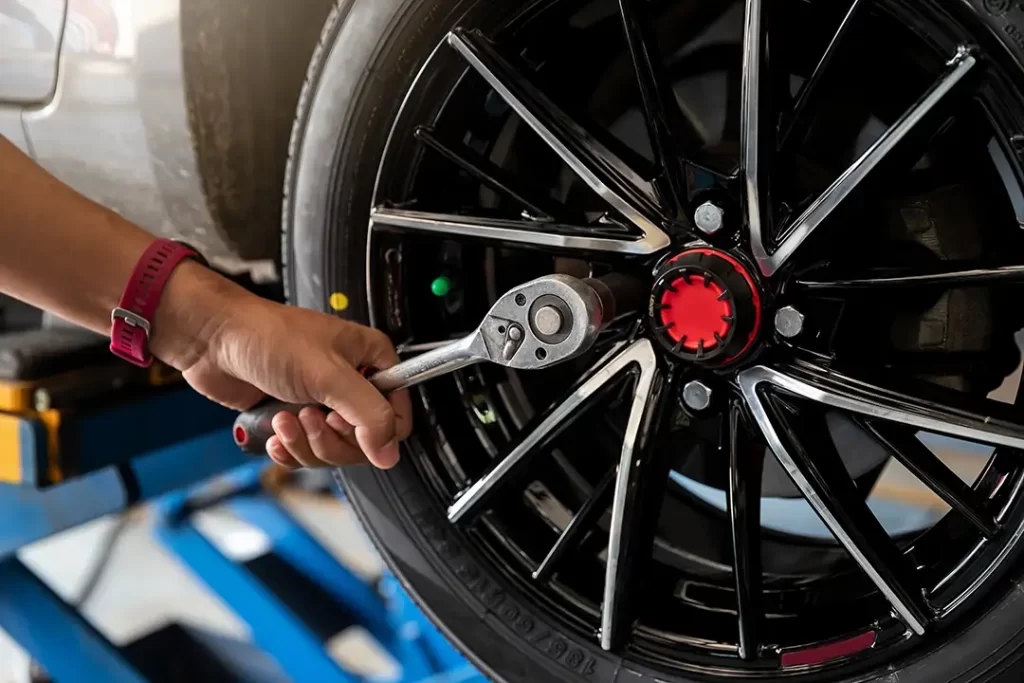Regularly replacing the tires on your car is an important part of regular maintenance. You can extend the life of your tires and improve your car’s handling. You can even reduce your fuel costs by rotating your tires regularly.
The position of the tire on the vehicle can affect how it wears. Front and rear tires wear differently, for example, the front tire mounts make up more than 50-60% of your car’s weight, simply due to the extra weight of the engine. So the front tires of a front-wheel drive car will wear out before the rear tires. You can ensure that your tires wear evenly and do not wear out too quickly by rotating them frequently.
There are several different tire rotation patterns, depending on the type of vehicle and tires. Before you rotate your vehicle’s tires, it is important to understand the tread pattern, and the method you choose depends on certain factors, such as whether your tires are directional or non-directional. The most common patterns include:
- Cross-forward
- Cross-back
- X-pattern, and
- Straight-ahead.
The transmission, size, and type of tires all play a role in determining the best rotation pattern for your vehicle. In this article, we will define tire rotation, discuss its importance, and outline the steps needed to implement it.
The Importance of Regular Tire Rotation
Regular rotation extends the life of your tires, this simple manipulation saves you time and money in the long run. The essence of rotation is to periodically swap the wheels. Thanks to this, the tires wear more evenly, they can serve you much longer and maintain optimal driving characteristics throughout their entire service life, until the very last day of operation.
Your car’s operating manual most likely contains information on how often it is recommended to rotate the wheels. If this information is not available, follow the recommendations of the tire manufacturers. Specialists from the Dallas Complete Auto believe that it is necessary to rotate every 6-8 thousand kilometers. If you have a spare wheel, you should also include this in the rotation.
Why do you need to rotate your tire?
Tire rotation is an important part of car maintenance for several reasons. It helps extend the life of your tires by ensuring that they wear evenly. First, tires that wear unevenly have a shorter lifespan, leading to costly replacements sooner than necessary.
Secondly, rotating your tires can improve your car’s handling and performance. When you rotate your tires regularly, they wear evenly, resulting in a more balanced and stable ride. This means your car will handle and grip the road better, especially when cornering or braking.
Third, rotating your tires regularly will help you save on fuel. When your tires wear unevenly, they create more rolling resistance, which forces your engine to work harder and burn more fuel. By rotating your tires, you can reduce rolling resistance and improve your fuel economy.
Finally, tire rotation is necessary for safety reasons. Uneven tire wear can create stability and control issues, especially on wet or slippery roads. This can lead to reduced traction, poor braking performance, and even accidents. By ensuring that your tires wear evenly, you can make your vehicle safer to drive.
When should you change your tires?
In addition to the make and model of your vehicle, driving conditions and tire type affect how often you should rotate your tires. You can avoid flat spots on your tires by rotating them every 6,000 to 8,000 miles or every six months. You should also consult a service technician or check your owner’s manual.
It is also important to rotate your tires before you notice signs of uneven wear. An easy way to check your tires is to look for signs of uneven tread wear, such as bald spots or areas with less tread than others. You can also check the tread depth with a tire tread depth gauge. If the tread depth varies significantly from one tire to the next, it is time to replace your tires.
How to flip tires?
Tire rotation is a simple process that you can do at home using the proper tools and equipment.
- Choose the right tire size based on your strength level;
- Stand with feet shoulder-width apart, facing the tire;
- Squat down and grip the bottom of the tire with both hands;
- Keep your back straight and core engaged;
- Drive through your legs and lift the tire upward using your hips and legs;
- As the tire reaches chest height, step forward;
- Push the tire forward while flipping it over;
- Follow through and let it land flat;
- Reset your stance and repeat the motion;
- Use gloves to protect your hands.
How do you rotate tires?
Different vehicles and different types of tires require different approaches to tire rotation. You should rotate the tires every 6,000 to 8,000 miles, with this range varying depending on your vehicle and driving habits.
The exact tire rotation pattern will vary depending on the make and model of your vehicle. You can rotate the tires in two directions: front to back and diagonally by following the manufacturer’s instructions.

🗒️ Note:
In summary, tire rotation is an important part of car maintenance that can improve your vehicle’s performance and safety. If you rotate your tires regularly, the tread will wear at the same rate, which will reduce your fuel costs. Rotating your tires is an important maintenance task, so make sure you know how to do it or consult your owner’s manual or a mechanic.
Feel vibration while driving or notice uneven tire wear?
How rotation and centering extend the service life of tires
Every driver dreams of buying tires that he can drive for several seasons. The service life depends not only on the quality of the tires themselves – other factors play a major role. One of them is the timely rotation of the wheels. It is necessary due to uneven wear, which is manifested when more load falls on one axis or side of the machine.
The front wheels suffer most often. They are responsible for effective braking in different situations, which is why they wear out faster. With uneven wear, the general balance of the car’s behavior on the road deteriorates – it becomes harder to drive the car, the level of stability and maneuverability decreases, and fuel consumption increases. That’s why they came up with the idea of changing tires in places.
But there are nuances here too – to carry out a possible rotation of the tire, you need to buy a set of discs or at least one type. Different types of models may not “take root” with each other due to different technical characteristics.
The best option is to buy rubber with a non-directional tread pattern. You can install them from any side of the front and rear axles, rotating in any way, and the main thing is to buy the same tires.
The driver should perform wheel alignment as soon as they notice uneven wear on the tread pattern. You should install tires with a smaller pattern on the rear axle so that the front slopes are fresher. When to change a tire depends on the intensity of driving and operating conditions, but tire manufacturers recommend doing it after every 8-10 thousand kilometers of road.
What is wheel alignment and why is it necessary?
Centering is better known in the driver’s circle as “balancing”. You must need it in order to extend the life of the suspension elements and the car to protect the tires from premature wear. There are almost no cases when the main mass of the wheel coincides with the geometric center. When driving, you can feel the vibration of the car, which has a bad effect on the suspension and steering, and the wear resistance of the tires decreases.
Centering is necessary for the front and rear wheels. The imbalance is broken when driving a certain distance on any axis, which reduces the level of safety on the road. You should carry out the wheel balancing in the following cases:
- After replacing or rotating tires;
- When you feel vibrations in the steering wheel or seat while driving;
- After hitting a pothole or curb;
- When new wheels or tires are installed;
- If there’s uneven tire wear;
- In case of any damage to tires and discs;
- As part of regular vehicle maintenance to ensure smooth driving.
In Conclusion
To center the wheels, you need to visit a tire repair service. Today it is not a problem to find it – they work in almost every district of large settlements. Specialists carry out this process by using a cone on a balancing machine, controlled by a computer program.
Timely wheel alignment and centering allow you to extend the service life of tires and car suspension parts. This will improve important driving performance, and most importantly, increase the safety of the driver and passengers on the road.
Frequently asked questions (FAQs) about tire rotation
Regular tire rotation ensures even tread wear, which helps extend the lifespan of your tires, improves fuel efficiency, and enhances your car’s handling and safety. Uneven wear can lead to poor traction and higher fuel costs.
Most tire manufacturers and experts recommend rotating your tires every 6,000 to 8,000 miles or every 6 months. If you drive in stop-and-go traffic or on rough roads, more frequent rotation may be necessary.
Common tire rotation patterns include the cross-forward, cross-back, X-pattern, and straight-ahead methods. The correct pattern depends on whether your tires are directional or non-directional and if your vehicle is front-, rear-, or all-wheel drive.
Tire rotation involves switching the position of the tires to ensure even wear. Wheel balancing, also known as centering, adjusts the weight distribution of each tire and wheel to prevent vibration, improve ride comfort, and protect suspension parts.
Proper tire balancing reduces vibrations, improves steering stability, protects suspension components, and prevents uneven tire wear. It’s essential after installing new tires, hitting potholes, or noticing vibration in the steering wheel.

